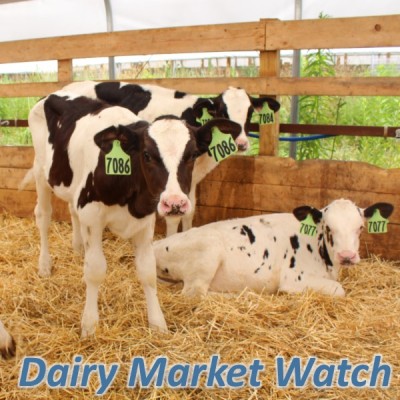Dairy Market Watch - September 2020
Alycia Drwencke, Dairy Management Specialist
Southwest New York Dairy, Livestock and Field Crops Program

Dairy Outlook: September 2020
PennState Extension
This is an excerpt from the originally published Outlook available here: https://extension.psu.edu/dairy-outlook-september-2020
Class III highs are receding, and prices in the short term are normalizing. Unknowns of fall consumer and restaurant demands continue to add volatility to futures markets.
The Mystery of Today's Milk Market Continues
Given the turbulence of the milk markets, and the markets in general, it is hard to predict where things are going with any reasonable sense of assurance. Class III prices have receded from the summer spike which caused most Pennsylvania farms to be impacted by a larger than usual negative Producer Price Differential. Class I and IV milk have improved from the lows of the spring, but are still off the anticipated pace from the end of 2020. Numerous factors continue to influence these futures, but for the time being, it appears both Class III and Class IV are normalizing in the $17/cwt. and $14/cwt. range respectfully for the rest of 2020. The Pennsylvania All Milk Price should stabilize around $19.25/cwt. for the same period if those prices come to fruition.
The Good and Bad of U.S. Dairy Consumption Trends
USDA recently released the 2019 dairy production consumption data per capita. Figure 1 outlines how fluid milk, total milk product (adjusted by milk fat equivalent), and annual U.S. milk production per capita have trended since 1975. No surprise, fluid milk has steadily decreased over the past 45 years, going from roughly 250 lbs. per person in 1975 to only 150 lbs. in 2019. Despite the drop in fluid milk, total dairy consumption has been steadily climbing for the same time. For the same period, average annual U.S. milk production had kept pace with that demand, until the early 2000s. Since then, U.S. production has outpaced per capita consumption. This isn't necessarily a concern, given this data does not reflect any export data for the same time period. When examining the recent trends in commercial disappearance versus milk production, the last two months have seen slightly better disappearance than that months production. However, given the continued influences of changing consumer demands and government interventions, supply and demand will continue to be fragile for the foreseeable future. There are some positive trends from consumer markets that exist beyond the reduced fluid milk and stagnant yogurt trends. Figure 3 takes a closer look at butter and total cheese (American, other than American, and Cottage) for the past twenty years. In that time, per capita consumption has increased nearly 26% for total cheeses (from 32 total pounds to nearly 42.5 lbs) and butter has increased by 38% (going from 4.5 lbs. in 2000 to over 6 lbs. in 2019). Hopefully these trends will continue to improve under the pandemic related shifts in eating patterns by consumers.
Dairy Market Watch 2020 09 (pdf; 2018KB)
Upcoming Events
Boots in the Barn: Cornell Dairy Research Updates
January 13, 2026
January 20, 2026
January 27, 2026
February 3, 2026
February 10, 2026
February 17, 2026
February 24, 2026
Join us for some or all!
Advanced Hoof Health Program
January 15, 2026
Belfast, NY
Who should attend?
- Professional hoof trimmers
- Dairy farm owners or managers in charge of farm foot health
Topics include:
- How to Create a Strategic Trimming Program for your Dairy
- The Latest in Lameness Technology for the Dairy Industry
- Housing and Flooring Design: Its Role in Hoof Care
Webinar: Converting Old Dairy Barns into swine Facilities
January 21, 2026 : Webinar: Converting Old Dairy Barns into swine Facilities
Tim Terry, Farm Strategic Planning Specialist with Cornell's Pro-Dairy program will share information on what it takes to transition an old dairy barn for swine production. We plan to cover flooring, ventilation, and lighting, considerations for system workability, and more! Registration is free.
Announcements
No announcements at this time.





